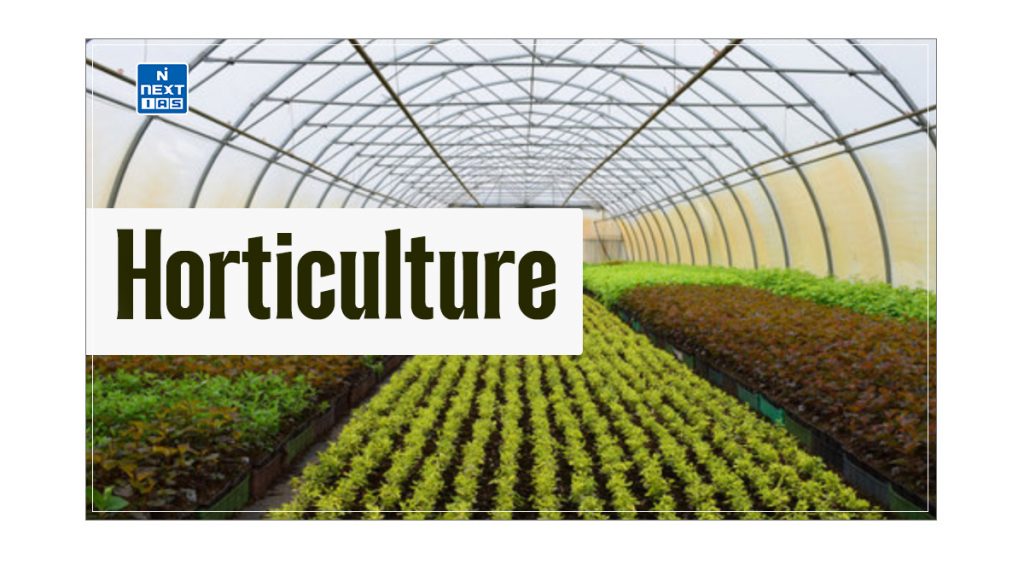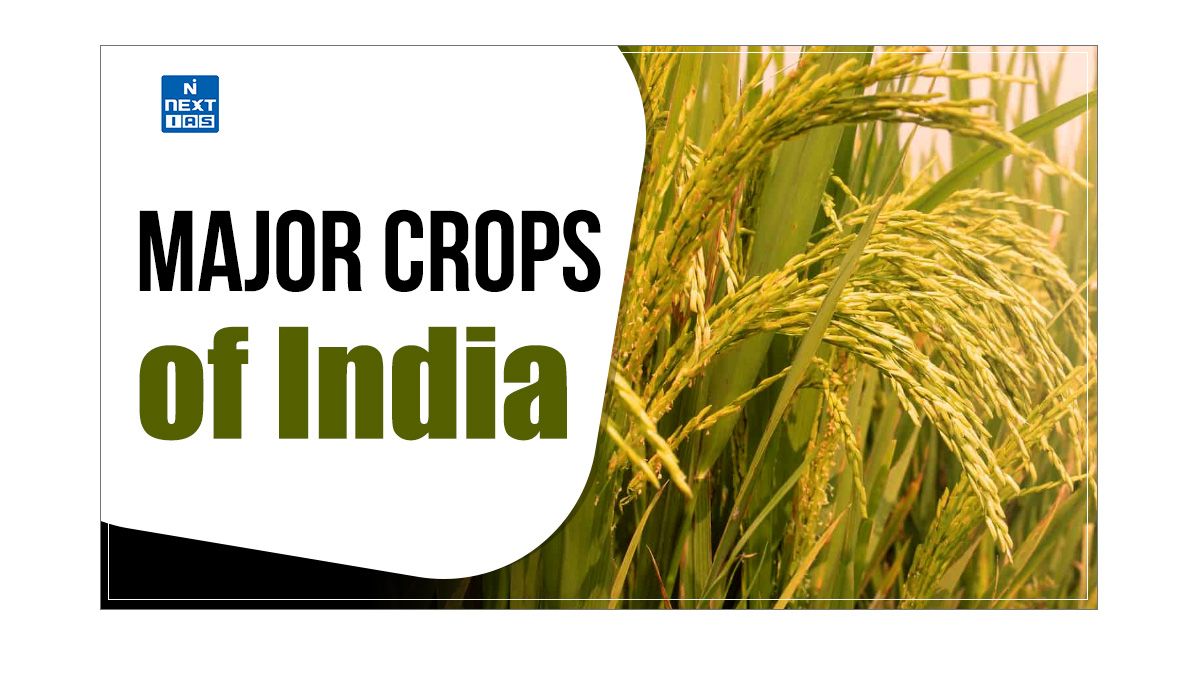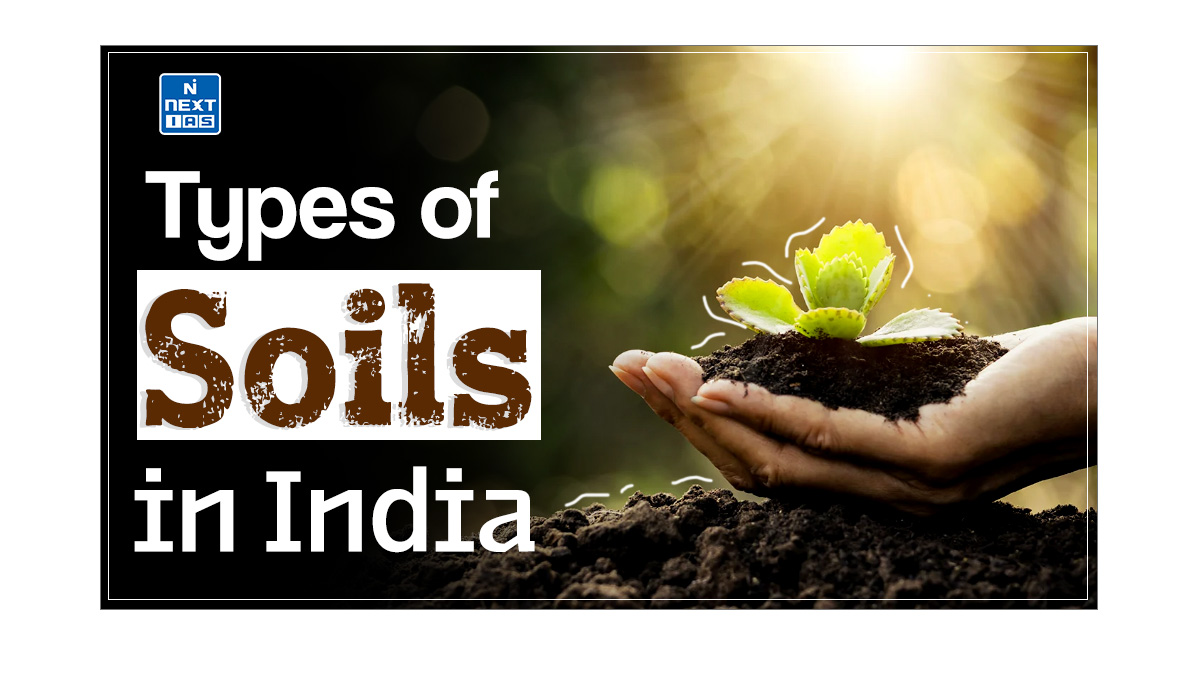
Horticulture plays a crucial role in India’s agricultural sector, encompassing the cultivation of various crops such as fruits, vegetables, spices, and ornamental plants. Given India’s varied agroclimatic conditions, it has emerged as a vital and productive branch of agriculture, contributing significantly to the country’s food security and economic growth. This article aims to study in detail the current state of horticulture in India, its major crops and regions, and the various initiatives and schemes designed to enhance the sector’s growth and productivity.
About Horticulture
- Horticulture is a branch of agriculture relating to cultivating fruits, vegetables, and ornamental plants.
- It is a capital and labour-intensive agriculture.
- India is bestowed with varied agroclimates, which are highly favourable for growing a large number of horticultural crops such as fruits, vegetables, spices, root tubers, ornamental, aromatic plants, medicinal species, and plantation crops like coconut, areca nut, cashew, and cocoa.
- Presently, these crops occupy about 10 per cent of the country’s gross cropped area and will produce about 330 million tonnes in 2021.
- India is the second largest producer of fruits and vegetables.
- The total production of fruits has been estimated at 102 million tons from 6.8 million hectares of land.
- Vegetables occupy an area of 10.8 million hectares and produce 196 million tons.
- The Father of Horticulture of world is Liberty Hyde Bailey.
- He was an American horticulturist, botanist, and co-founder of the American Society for Horticultural Science.
- For his extensive work in the field, he is often referred to as the “father of modern horticulture.”
- The Father of Horticulture in India is M.H. Marigowda.
- He was a visionary who revolutionized this field.
- He is highly respected for his significant contributions to the enhancement and progress of horticulture in Karnataka and India as a whole.
Types of Horticulture
The types of horticulture practised in India include:
Fruits (Pomology)
- Indian climate favor the development of a large range of varieties of fruits.
- Mango, banana, citrus, pineapple, papaya, guava, sapota (cheekoo), jackfruit, litchi, and grapes are among the tropical and subtropical fruits, whereas apple, pear, peach, plum, apricot, almond, walnut, among the temperate fruits and pomegranate, fig, phalsa, among the arid fruits are important.
Vegetables (Olericulture)
- Important vegetable crops grown in the country are potato, tomato, onion, chillies, carrot, radish, turnip, beans, lady finger, guard, lettuce, brinjal, cabbage, cauliflower, spinach, okra, and peas.
- India’s largest vegetable crop is potatoes, followed by Tomatoes.
- In area and vegetable production, India is second only to China and occupies the first position in the world in cauliflower production, second in onion production, and third in cabbage production.
Flowers (Floriculture)
- The availability of diverse agro-climatic conditions in the large country facilitates the production of all significant flowers throughout the year in some part or the other, and improved transportation facilities have increased the availability of flowers all over the country.
- Regarding flower production, Tamil Nadu has the highest share of flower production.
- A National Horticulture Mission (NHM) was launched in the country during the Tenth Five Year Plan, effective 2005 – 06.
- The mission’s main objectives are to enhance its production through area-based regionally differentiated strategies, improve nutritional security and income support to farm households, and promote and disseminate technologies.
Spices and Condiments Cultivation
- It involves growing spices like black pepper, cardamom, turmeric, ginger, and cumin.
- India is a major producer and exporter of spices, which play a significant role in its economy.
Plantation Crops
- Crop cultivation includes tea, coffee, coconut, areca nut, rubber, and cocoa.
- Plantation crops are essential for export earnings and support large-scale employment in India.
Medicinal and Aromatic Plants
- It focuses on growing plants with medicinal properties (like neem, aloe vera, and ashwagandha) and those used for aromatic oils (like lemongrass and sandalwood).
- These plants have significant demand in the pharmaceutical, cosmetic, and wellness industries.
Horticulture in India
- It cultivates garden plants, fruits, berries, nuts, vegetables, flowers, trees, shrubs, and turf.
- Horticulturists work in plant propagation, crop production, breeding, genetic engineering, biochemistry, physiology, storage, processing, and transportation.
- Horticulturalists use modern nurseries to produce seedlings and mother plants.
- These plants are propagated through different methods, such as seeds, inarching, budding, veneer grafting, patch budding, and softwood grafting.
| State | Remarks |
| Tamil Nadu | This State is suitable for horticulture because of its rich biodiversity and appropriate climate. Various tropical fruits, temperate fruits, vegetables, spices, condiments, plantation crops, medicinal herbs, aromatic plants and commercial flowers are grown here. |
| Jammu and Kashmir | This industry is the mainstay of Kashmir’s rural economy. Every year, this industry earns revenue of over Rs. 50 crores. Fruits cultivated in Kashmir include a variety of apples, pears, cherries, walnuts, almonds, peaches, saffron, apricots, strawberries, and plums. |
| Odisha | Here, it consists of cultivating fruits like pineapple, mango, and cashews, vegetables like mushrooms, drumstick, and onions, and spices like ginger and turmeric. Strategies by the State Government for promoting horticulture include supplying better-quality planting material at subsidised rates, conducting training programs, conducting field demonstrations, and encouraging cultivation at lift irrigation points. |
| Punjab | Around 82,600 hectares of land were planted with horticulture crops until 2002. This area has grown significantly since then. Currently, fruits like sweet orange, kinnow, guava, peach, litchi, and mango are grown in the region. |
| Maharashtra | It involves the cultivation of fruits like bananas, figs, grapes, custard apples, wood apples, jambul, pomegranate, mandarin orange, guava, and sweet orange. Vegetables, medicinal plants, and spices are also grown in the state. |
| Tripura | It is the land of high hills and hillocks interspersed with rivers and valleys. Its moderately warm and humid climate is coupled with well–distributed annual rainfall of 2500 mm. This terrain and climate are ideally suited for rainfed horticulture. Fruits like pineapple, jackfruit, orange, litchi, cashew nut, coconut, lime, and lemon are produced in abundance. |
| Assam | Some of the popular horticulture crops grown in Assam are carambola, wood apple, jackfruit, ginger, oranges, olives, figs, and bamboo shoots. Almost 75 per cent of the state’s population derives its livelihood from agriculture and horticulture. |
| Andhra Pradesh | This State has a varied climate and is suitable for various horticultural crops. It leads to the production of citrus, chillies, turmeric and oil palm. Andhra Pradesh is also a major producer of cocoa, cashew, guava, coriander, banana, ginger and coconut. |
National Horticulture Mission
- The National Horticulture Mission (NHM) is a government initiative launched in 2005-06 to promote the holistic development of horticulture in India.
- It aims to enhance the production of fruits, vegetables, flowers, spices, and medicinal plants by supporting the adoption of modern technologies, improving infrastructure, and encouraging sustainable farming practices.
- The mission focuses on increasing productivity, ensuring the availability of quality planting material, promoting post-harvest management, and enhancing market access for horticultural produce.
- By fostering diversification in agriculture, the NHM contributes to increasing farmers’ incomes and improving food and nutritional security in the country.
National Horticulture Board (NHB)
- The National Horticulture Board (NHB) is an autonomous organisation established in 1984 under the Ministry of Agriculture and Farmers Welfare.
- The primary mandate is to promote the integrated development of the horticulture sector in India by offering financial assistance and technical support.
- The National Horticulture Board (NHB) plays a crucial role in improving the production and quality of horticultural crops, focusing on areas like post-harvest management, cold chain development, and market infrastructure.
Importance of Horticulture in India
- It is significant in India due to its significant contribution to its agricultural economy and food security.
- It encompasses various crops, including fruits, vegetables, flowers, spices, and medicinal plants, essential for nutritional security and improving the population’s health.
- It plays a crucial role in providing employment opportunities, particularly in rural areas, and contributes to the income of small and marginal farmers.
- It also enhances export earnings, as India produces horticultural products like mangoes, bananas, and spices.
- Additionally, it supports sustainable agriculture by promoting crop diversification, reducing the pressure on traditional food crops, and improving soil health through organic farming practices.
Mission for Integrated Development of Horticulture (MIDH)
- It is a centrally sponsored scheme launched to promote the holistic development of horticulture in India.
- The scheme, which took off from 2014-15, integrates the ongoing schemes of the National Horticulture Mission, Horticulture Mission for North East & Himalayan States, National Bamboo Mission, National Horticulture Board, Coconut Development Board, and Central Institute for Horticulture, Nagaland.
Objectives of Mission for Integrated Development of Horticulture
The main objectives of the Mission for Integrated Development of Horticulture in India are:
- Promote holistic growth of this sector, including bamboo and coconut, through area-based regionally differentiated strategies, which include research, technology promotion, extension, post-harvest management, processing, and marketing, in accordance with each state/region’s comparative advantage and diverse agro-climatic features.
- Encourage the aggregation of farmers into farmer groups like FIGs/FPOs and FPCs to achieve economies of scale and scope.
- Microirrigation can enhance production, augment farmers’ income, and strengthen nutritional security. It can also improve productivity through quality germplasm, planting material, and water use efficiency.
- Support skill development and create employment generation opportunities for rural youth in horticulture and post-harvest management, especially in the cold chain sector.
Strategy to achieve objectives
To achieve the above objectives, the mission will adopt the following strategies:
- Adopt an end-to-end holistic approach covering pre-production, production, post-harvest management, processing and marketing to ensure appropriate returns to growers/producers.
- Promote research and development technologies for cultivation, production, post-harvest management, and processing, with a particular emphasis on enhancing cold chain infrastructure to extend the shelf life of perishables.
- Provide farmers with advanced technology for high-tech horticulture, including protected cultivation and precision farming.
- Enhance post-harvest management, processing for value addition, and marketing infrastructure.
- Foster a coordinated approach by encouraging collaboration and synergy among R&D, processing, and marketing agencies across public and private sectors at national, regional, state, and local levels.
- Promote FPOs and their tie-up with Market Aggregators (MAs) and Financial Institutions (FIs) to support adequate returns to farmers.
Conclusion
As India continues to harness its potential in horticulture, the focus must remain on advancing production techniques, improving post-harvest management, and supporting farmer incomes. Initiatives like the Mission for Integrated Development of Horticulture (MIDH) and other sector-specific schemes offer an opportunity to bolster the horticultural landscape further. This will ensure sustained growth, increased productivity, and better economic prospects for those involved in this essential sector.
Frequently Asked Questions (FAQs)
What are horticulture crops?
These crops include fruits, vegetables, flowers, nuts, seeds, herbs, spices, and ornamental plants.
Who is the father of horticulture?
The title “Father of Horticulture” is often attributed to Liberty Hyde Bailey, an American horticulturist and botanist.






